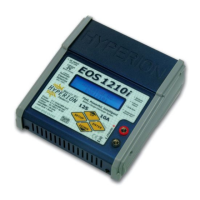* The DataPort version EOS chargers, when connected to LBA10 balancer via cable #HP-EOSLBA10-DPC, allow the user to
monitor the individual voltages of each battery cell during the charge process. This is an important addition to pack diagnostics,
as one is able to see the exact balance status of the battery pack (or packs, when LBA10 is in NET mode).
To view individual cell voltages during the balance charging, connect a DataPort Cable (DPC) between Charger and LBA10 as
shown by the Green line in diagram below. No matter if single or networked LBA, connect DPC to
Master
LBA. Note that DPC
Port is on
right
side of EOS 1210i charger, not left as is shown in this generic diagram…
TROUBLESHOOTING
(1) Check again that the battery you are trying to charge and the settings on the EOS 1210i match. Battery type (such as NiMH
or Lithium), battery capacity, number of cells (charge voltage), and charge rate must all be correct.
Note again that original (non
A123) LBA10 will cause Charger Error Message
DATA RANGE OVER ERROR
if LBA is connected to 1210i via
DataPort Cable
a
nd
1210i is set for A123 Cell Type.
(2) Check that the input cable and output cables:
*Have proper connectors in good condition *Are not frayed, worn, cut, or damaged
*Are the proper gauge (2.5mm, 14ga) *Are proper length - 20cm (8”) on output side
(3) Attach the charger input connectors to a 12V automotive battery that is in good condition and fully charged. Wiggle the
Terminal clips into the battery posts to insure that you have a good connection. Many charger problems are due to poor quality
or inadequate switching AC-DC power supplies, so this test is necessary to eliminate those from the list of suspects.
(4) Try another battery for charging. If your RC battery is in poor condition,
over discharged
, or in some other way defective
the charger may correctly refuse to charge it based on safety algorithms.
(5) Try another RC battery type. For example switch to a NiMH battery if you are failing to charge Lithium types. Success with
one type but failure with another generally indicates that the charger is working properly. The failing battery type is almost
certainly in poor condition, then, or you have improperly set the charger for it.
(6) Contact your dealer with full details and description of the problem, including the type of input power source, RC battery type
and cell count, and history of the charger - that is, has the charger been working properly before, or failing from new condition?
WARRANTY
HYPERION Chargers are guaranteed to be free from defects in materials and workmanship for a period of one calendar year from
date of purchase.
Your selling dealer is your first point of contact for warranty issues.
Return postage costs are the
responsibility of the user in all cases. Submit copy of original receipt with the return.
Damage due physical shock (dropping on the floor, etc), inappropriate power supply (automotive battery charger, etc!), water,
moisture, and humidity are specifically NOT covered by warranty.
It is well to carefully check your charger before making a
return, as problems in setup, cabling, or power supply are much more common than defects in the charger.
Enjoy the Power!
The Hyperion Team

